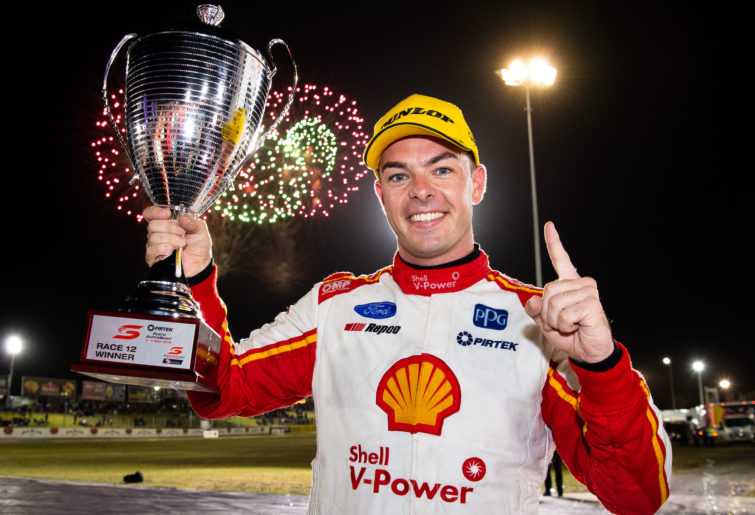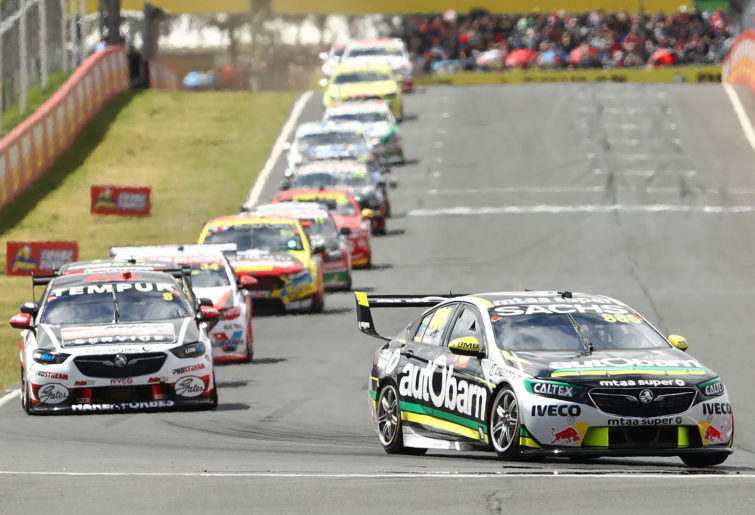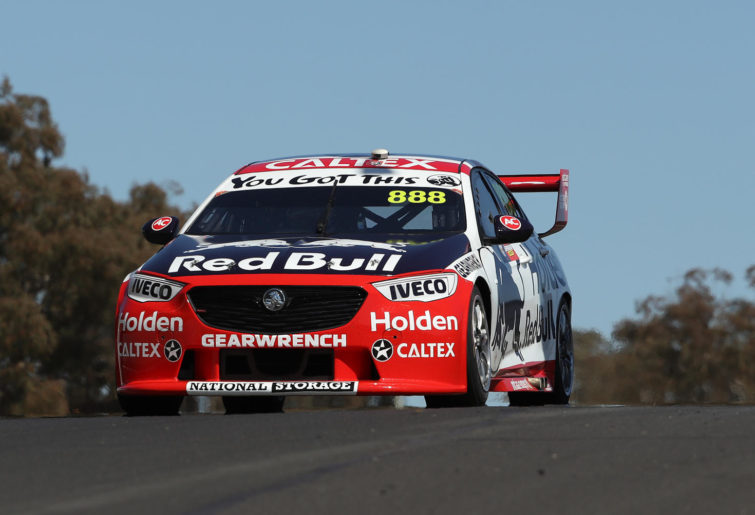'P---es me off': Ricciardo fuming over rival's response to crash that ended his Chinese GP
Ricciardo was forced to retire after the Aston Martin driver slammed into the back of his car during a safety car restart but Stroll…
Opinion
Let’s look towards the 2020 competition through the lens of the shambles that was 2019.
About this time last year Supercars CEO Sean Seamer was probably thinking very positively about 2019. He had announced completion of the homologation of the new Mustang with aerodynamic testing results (VCAT) that were “the closest the three models (Mustang, Commodore and Altima) had ever been”, and was no doubt expecting 2019 to be a good year overall. There was surely lots to look forward to!
So, how did that pan out and what does 2020 look like?
A new model was introduced (Ford Mustang), replacing one that had been out of production for over two years – and a new body style with it – the first two-door coupe in Supercars.
The outcome was negative. Someone slipped a better mousetrap through the homologation process, unleashing the greatest parity debacle in the history of Supercars.
Six changes and 23 races into a 32-race calendar they were done.
How well it was done is open to debate. The first ten races of the season delivered 19 Mustang podiums (nine wins, eight seconds and two thirds, with eight podiums being attributed to Scott McLaughlin) and the last ten races delivered nine Mustang podiums (two wins, four seconds and three thirds, with four podiums being attributed to McLaughlin).

(Photo by Daniel Kalisz/Getty Images)
In terms of the results that matter – wins and podiums – it could be argued that they went a bit too far the other way.
There was an expectation that the close battle between the main protagonists (Triple 8 and DJR Team Penske) would continue, and that teams showing promise in 2018 (particularly Erebus and 2018 debutant Matt Stone Racing) would continue to evolve.
The outcome had both positives and negatives. The racing was actually pretty good and the teams showing promise delivered and continued to evolve, with a few new stars of the sport emerging – particularly Anton de Pasquale and Todd Hazelwood, who delivered on the promise they had previously shown. Given the right equipment they could be championship contenders in the future.
The implementation of meaningful and significant cost-saving measures through the banning of complex and expensive twin spring shock absorbers and the introduction of the X-Trac transaxle (replacing the previous reliable-but-high-maintenance Albins unit) offered a further significant reduction in maintenance costs.
That outcome was positive. It was generally agreed that these measures worked and the competition was shaken up a little as the teams came to terms with the new shock absorber rules.
There was a Supercars technical administration team that had never been as strong, headed by Adrian Burgess and Campbell Little.
That outcome was also positive. These guys are good, but they certainly had their work cut out for them!

(Photo by Robert Cianflone/Getty Images)
There was a schedule to deliver the Gen 3 regulations ahead of a planned 2021 introduction.
The outcome was positive or negative. It became clear that the workload created by the parity debacle would cause this one to slip, so it was no surprise when it was announced that it had slipped to a 2020 release ahead of a 2022 introduction.
This could be a blessing in disguise given the uncertainty around Holden’s long-term presence in the Australian market. They can also use this opportunity to eliminate the possibility of a better mousetrap slipping through the homologation process by improving the framing of the regulations and introducing proper aerodynamic testing to the process by mandating the use of a wind tunnel.
There was a huge step forwards in the technical specification of the Supercars-owned SuperUtes category that should significantly improve the quality of racing, addressing the key concerns of fans about the clumsy, tyre-squealing yawn-fest that the inaugural 2018 competition had been – and hopefully attracting some additional entries to the grid.
That outcome was negative. Grids remained thin, the racing improved a bit, the fans remained ambivalent and the category determined that perhaps they needed to retro-fit V8s to add to the show and reduce costs.
Supercars ultimately decided that it was all too hard and threw it back over the fence to let the competitors sort it out. It may or may not survive 2020 as a top-line category, but it’s no longer Supercars’ problem.
The re-branding of the classic touring cars as Super3 brought the category into alignment with the Supercars strategy of creating a clear development pathway for aspiring drivers to work through on their journey to the main game, from Super3 to Super2 to VASC.
That outcome was negative. It was an idea that didn’t really work and probably wasn’t needed. Like SuperUtes, it has now been thrown back over the fence. Beyond having Super2, the pathway idea to bring on new drivers is questionable.
The average tenure of full-time drivers in the sport is about eight years, meaning a churn rate of about three a year, assuming a 24-car field, and the majority of the churn occurs at the bottom end of the field, with the average tenure of the 2019 top five being 10.6 years – 11.6 years for the top three.
The bottom line here is that there aren’t many places available and it’s inevitable that the fastest, most talented drivers will make it to the top – it’s impossible for a driver to buy his or her way to a championship.
On that note, in 2020, it will be interesting to see how Jack Smith fares having bought his way into the main game. Prediction: he will be challenged to break into the top 20 at any event and Brad Jones Racing (the team he is paying to put his car on the track) will have plenty of work for their panel shop.
Last season also saw the prospect of Supercars being able to expand their brand through becoming the successful tenderer to the Bathurst Regional Council’s call for an additional event to be added to the Bathurst calendar.
This outcome was negative. This is one that got away, quite possibly from the Bathurst Regional Council as well.
Supercars presented an excellent bid that was something different from the other proposals, being more like an Australian version of the Goodwood festival. Instead the BRC chose to have another race meeting. Time will tell.
Let’s have a look at the challenges in 2020.
Parity
The revised VCAT process will deliver on its aim and even a worst-case scenario will still deliver a much more balanced technical parity outcome than was the case throughout 2019.
The remaining underlying issues can be addressed through the mechanism of the Gen 3 regulations due for release this year.
Holden and Mary T Barra, chairman and CEO of GM
Holden don’t have a car to compete with post 2021. And, with Mary T Barra at the helm of GM, they possibly won’t be around for much longer. Under her stewardship GM’s global program of divestiture, rationalisation and regionalisation must be making the stakeholders very nervous.

(Photo by Robert Cianflone/Getty Images)
This is a biggie for Supercars, going right to the heart of their sporting and business model. Whichever way you slice it, there doesn’t appear to be a lot of upside for Holden or Supercars.
Paul Scurrah
Paul Scurrah is the head of Virgin Australia, the naming rights sponsor of Supercars under a five-year deal struck by John Borghetti, former Virgin Australia chief executive and known petrol head, that became effective from 1 July 2016, along with the change in branding from V8 Supercars to Supercars. This deal is up for renewal this year, or at least up for discussion ahead of 2021.
The problem is that Virgin continues to bleed money – their 2019 loss of $349.1 million was announced in conjunction with a commitment to cut 750 jobs as a part of a $75 million cost reduction target for FY 2020. And this is the seventh consecutive annual loss, announced just days from Qantas’ announcement of profitable domestic operations. Clearly there is something that Qantas is doing that Virgin isn’t, or vice versa. A bit like Triple 8 and DJRTP compared to the rest of the Supercars field.
Scurrah is under the pump. He’s been in the role less than 12 months and is no doubt looking to make a good impression on the shareholders with the FY20 results, which will invariably include taking a long hard look at the marketing spend.
It might be prudent for Supercars to be having tentative discussions with potential replacements, just in case.
Media rights
The current six-year media rights deal is due for renewal. The media landscape is a lot different today than it was back in 2014, and the challenges facing the sport in terms of market relevance and audience engagement and retention are much greater – and that trend is continuing.
Two big strategy questions arise apart from dollars: how long should the new deal run for and is continuing to lock away the competition behind a paywall (Foxtel) the right way to go?
There are lots of opinions here, but whatever the outcome, I can’t see any future media rights deal delivering the same revenue stream to the sport that the current one does.
The competition
The competition for the eyeballs and dollars of the current and potential future audience continues to get hotter with each passing year – from within Australia and overseas, from within the broad category of motorsports and beyond.
The success of TCR, the good prospects for S5000 and the increasingly high-profile Bathurst 12 Hour are all examples of competition from within Australia and from within motorsports that can’t be ignored.
On the overseas and other sports competition front, Wikipedia lists over 100 World Cups alone. Many of them are for recently emerging sports, particularly the women’s version of existing sports, and they all want their time in the sun for that audience, and the media rights and sponsorship revenue that flows with it.
The bottom line for 2020
The 2020 edition of the Supercars Championship is, for the most part, already squared away – sponsors are in place, cars are built, commitments have been made.
The competition should be good, notwithstanding the fact that the only drivers able to win the championship are Scott McLaughlin, Jamie Whincup and Shane van Gisbergen. That’s harsh, but true.
Cost savings in the form of spec shock absorbers and some engine restrictions will deliver some financial relief to the teams, and the new shocks, the reduced downforce and the abolition of tyre banks (a requirement to use a mix of old and new tyres at most events) will provide some additional variety that can only be a good thing.
Whichever way you slice it, the bottom line for the Supercars administration in 2020 appears to be the bottom line for the sport in 2021 and beyond. The big challenges that Supercars face this year are all about the financial model for 2021, 2022 and beyond. What will the revenue streams look like? How will the cost base be managed? Who will be the manufacturers that have cars on the grid?
I hope the answers are good ones. I know that none of them will be easy.